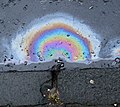Miscibility
Miscibility is a term used in chemistry to describe the ability of two or more substances to mix in any ratio, forming a homogeneous solution. The term is most often applied to liquids, but it can also apply to solids and gases. Miscibility is an important concept in various scientific and industrial fields, including pharmacology, chemical engineering, and environmental science.
Overview[edit]
Miscibility refers to the capacity of substances to mix without separating into two phases. When two liquids are miscible, they will blend into each other to form a single phase, regardless of the amount mixed. Conversely, if two substances are immiscible, they will not form a homogeneous mixture but will separate into layers or phases. The degree of miscibility can vary between complete miscibility (where the substances can mix in all proportions) and partial miscibility (where there is a limit to the proportion of substances that can mix).
Factors Influencing Miscibility[edit]
Several factors can influence the miscibility of substances, including:
- Polarity: Substances with similar polarities (e.g., two polar liquids like water and ethanol) are more likely to be miscible. This is due to the fact that like dissolves like; polar substances are more soluble in polar solvents, and non-polar substances are more soluble in non-polar solvents.
- Temperature: The miscibility of some substances can change with temperature. For example, an increase in temperature can increase the miscibility of two liquids.
- Pressure: Changes in pressure can also affect the miscibility of gases in liquids. According to Henry's law, the solubility of a gas in a liquid is directly proportional to the pressure of the gas above the liquid.
Applications[edit]
Miscibility has important applications in various fields:
- In pharmacology, the miscibility of drugs with solvents can affect their formulation and delivery.
- In chemical engineering, understanding the miscibility of different liquids is crucial for processes such as extraction, distillation, and chromatography.
- In environmental science, miscibility can influence the behavior of pollutants in water and soil.
Miscibility Gap[edit]
A miscibility gap is a range of compositions over which two substances are not miscible. This concept is particularly relevant in the study of binary liquid mixtures, where the miscibility gap can be represented on a phase diagram. The gap indicates the range of concentrations in which the mixture will separate into two distinct liquid phases.
See Also[edit]
References[edit]
<references/>
-
Diesel rainbow
Ad. Transform your life with W8MD's Budget GLP-1 injections from $75


W8MD offers a medical weight loss program to lose weight in Philadelphia. Our physician-supervised medical weight loss provides:
- Weight loss injections in NYC (generic and brand names):
- Zepbound / Mounjaro, Wegovy / Ozempic, Saxenda
- Most insurances accepted or discounted self-pay rates. We will obtain insurance prior authorizations if needed.
- Generic GLP1 weight loss injections from $75 for the starting dose.
- Also offer prescription weight loss medications including Phentermine, Qsymia, Diethylpropion, Contrave etc.
NYC weight loss doctor appointmentsNYC weight loss doctor appointments
Start your NYC weight loss journey today at our NYC medical weight loss and Philadelphia medical weight loss clinics.
- Call 718-946-5500 to lose weight in NYC or for medical weight loss in Philadelphia 215-676-2334.
- Tags:NYC medical weight loss, Philadelphia lose weight Zepbound NYC, Budget GLP1 weight loss injections, Wegovy Philadelphia, Wegovy NYC, Philadelphia medical weight loss, Brookly weight loss and Wegovy NYC
|
WikiMD's Wellness Encyclopedia |
| Let Food Be Thy Medicine Medicine Thy Food - Hippocrates |
Medical Disclaimer: WikiMD is not a substitute for professional medical advice. The information on WikiMD is provided as an information resource only, may be incorrect, outdated or misleading, and is not to be used or relied on for any diagnostic or treatment purposes. Please consult your health care provider before making any healthcare decisions or for guidance about a specific medical condition. WikiMD expressly disclaims responsibility, and shall have no liability, for any damages, loss, injury, or liability whatsoever suffered as a result of your reliance on the information contained in this site. By visiting this site you agree to the foregoing terms and conditions, which may from time to time be changed or supplemented by WikiMD. If you do not agree to the foregoing terms and conditions, you should not enter or use this site. See full disclaimer.
Credits:Most images are courtesy of Wikimedia commons, and templates, categories Wikipedia, licensed under CC BY SA or similar.
Translate this page: - East Asian
中文,
日本,
한국어,
South Asian
हिन्दी,
தமிழ்,
తెలుగు,
Urdu,
ಕನ್ನಡ,
Southeast Asian
Indonesian,
Vietnamese,
Thai,
မြန်မာဘာသာ,
বাংলা
European
español,
Deutsch,
français,
Greek,
português do Brasil,
polski,
română,
русский,
Nederlands,
norsk,
svenska,
suomi,
Italian
Middle Eastern & African
عربى,
Turkish,
Persian,
Hebrew,
Afrikaans,
isiZulu,
Kiswahili,
Other
Bulgarian,
Hungarian,
Czech,
Swedish,
മലയാളം,
मराठी,
ਪੰਜਾਬੀ,
ગુજરાતી,
Portuguese,
Ukrainian

